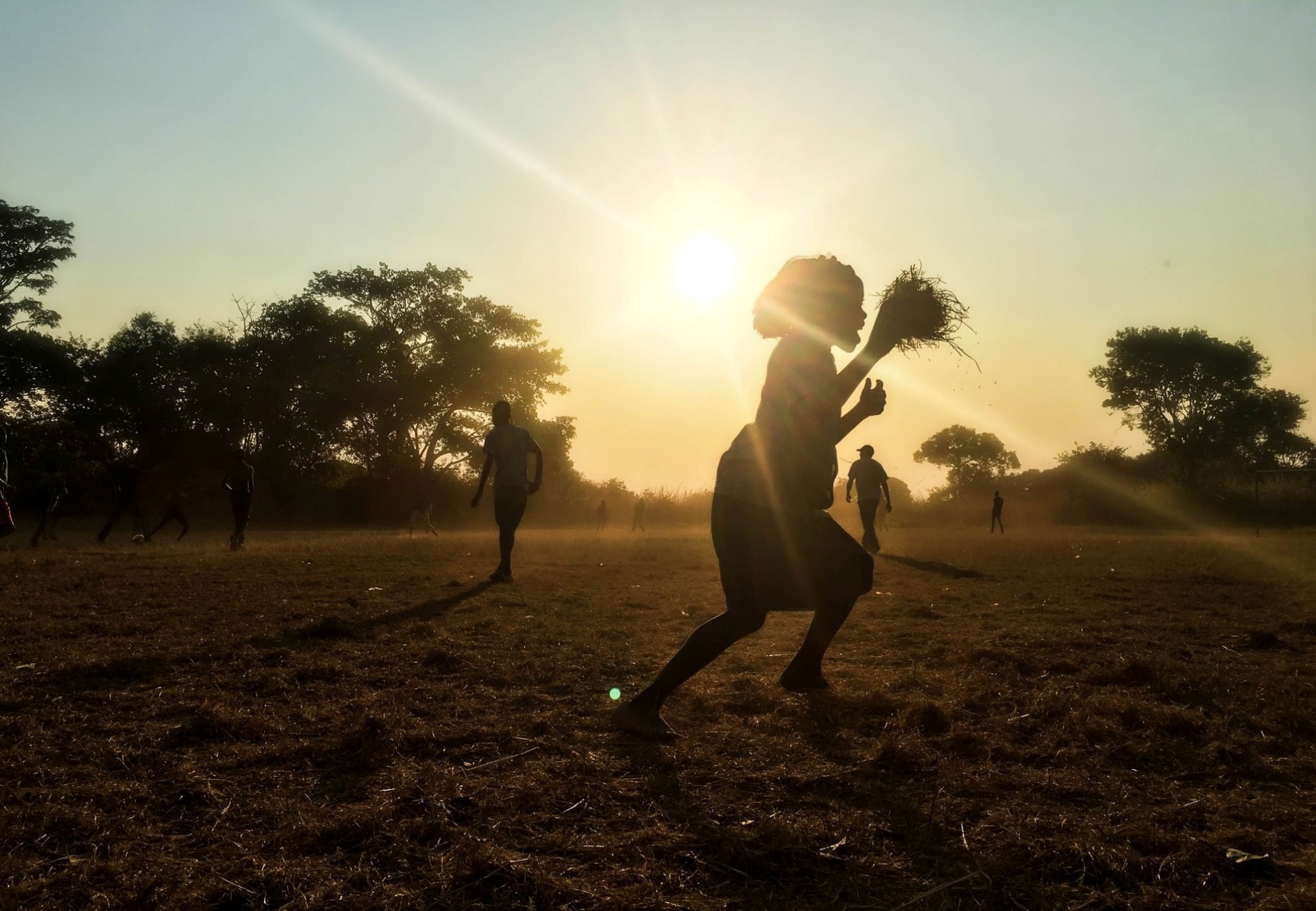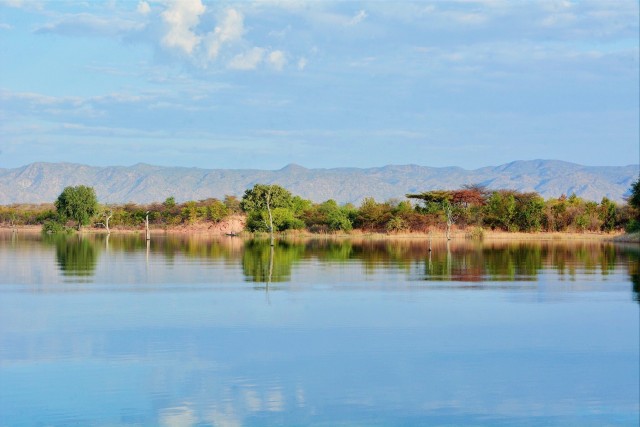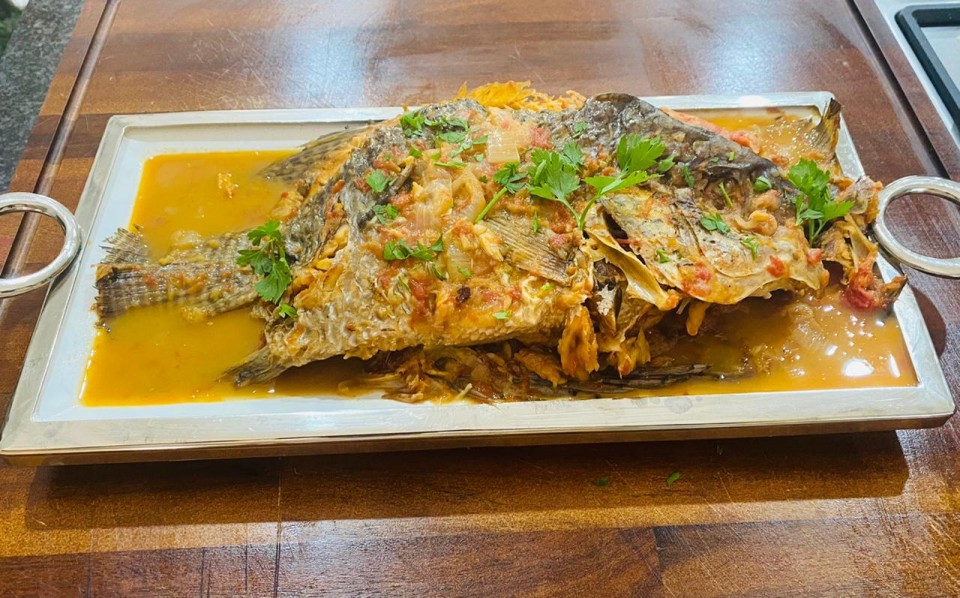Zambian cuisine with Jessie Chipindo
and her recipe for dry fish stew

Zambia
What do you remember about the food you ate food growing up?
“Nshima, our local staple, is hard porridge and usually made from maize meal or cassava flour. We would usually have it as a side dish to beef, chicken or fish stews. Weekends or special occasions meant special food like chicken or beef roasts, baked potatoes, cake for dessert or our favourite: peanut brittle. My siblings and I were always fascinated by the process of how the caramel goes from liquid to solid.”
It sounds like your fascination with cooking started early!
“I’ve had the opportunity of being exposed to great food from a young age, yes. I spent part of my teenage years living with one of my sisters in Chipata, in the eastern part of the country. There’s a large Indian community there, where food is a huge part of the culture especially during religious festivals, so I learned quite a lot about Indian food and spices."
[Forced displacement from India to Africa - predominantly under British rule - was common. Many Indians stayed on the continent.]
“My sister and I did a fair bit of travelling, which allowed me to see and experience many different cuisines. I collected spices from many different destinations, and she would always let me cook anything I wanted with whatever I had found.”
You started working at a young age, is that right?
“Yes. My parents passed on when I was young. I lost my father when I was 13 and my mother when I graduated high school. Unfortunately, a year after I started working as a guest house manager, I had to return home as my sister was ill. I came back to be her caregiver when she was in hospital. She died two months later. She supported everything I did, and always encouraged me. I owe a lot to her. May she rest in eternal peace.”
How did you arrive at the decision to open your own restaurant?
“While working as a cashier in a casino, I started baking and selling cakes. This went so well that I could eventually pursue my dream and open my first restaurant.
“Opening that restaurant was the most stressful day of my life. I thought I was going to die, haha! I compiled the menu, but didn’t have time to cook and try all of the recipes. On the first day, I prepped a few dishes that I thought people were gonna order at lunchtime. Guests started pouring in, and to my surprise, they mostly ordered stuff I hadn’t prepared for! But I survived and lived to cook another day.”

What are your favourite ingredients?
“I love cooking with fish and seafood. Those are the most delicious, healthy and versatile ingredients to work with. There are many different species of fish in Zambia, but the freshwater bream (also known as tilapia) is the most celebrated one. It’s abundant in all rivers and lakes and now also commercially farmed.
“My favourite Zambian dish is the dish that we’ll talk about later: dry fish stew. We have a lot of dried foods in Zambia. There didn’t use to be electricity or freezers in the villages, but the people still had to preserve the excess from the harvest for the rest of the year. That’s why they dried everything. Fish, game, vegetables, fruit, grains, legumes, anything really. These days, fresh produce and ground peanuts are very commonly used, too.”
Are there many regional differences in Zambian cuisine?
“Definitely. Zambia is a culturally rich country. We have just about the same staple products throughout the country, but some are indigenous to some areas and so are some recipes. Cooking methods tend to change from region to region as well.
“The southern province is known for livestock farming, so they have a lot of dairy products like sour milk. The northern province is known for growing lots of beans, and the west is big in fish. But don’t get it twisted! Zambia has a lot of freshwater sources in terms of dams, rivers and lakes, so fish is common all around the country.”

The Dish
Is dry fish stew popular across the country?
“It’s a true indigenous Zambian dish and it’s popular across the country. Not all people prepare it the same way though; the fish can also be grilled or fried. The recipe included here is the most traditional version, in which it’s stewed.”
Are there any traditions or special occasions involved?
“Not really. It’s a normal dish that people enjoy with their everyday nshima, and it works both for lunch and for dinner. Just serve it up and enjoy the same way you would any other stew!”
The Ingredients
- 4
- dried breams (or any other dried fish of your choice, like tiger fish)
- lots of water
- 125 ml
- vegetable oil
- 1
- medium-sized onion, finely diced
- 3
- large, ripe tomatoes, peeled and finely chopped
- a few fresh cabbage leaves
- 3
- spring onions, finely chopped
- salt to taste
- 4
- dried breams (or any other dried fish of your choice, like tiger fish)
- lots of water
- 1/2 cup
- vegetable oil
- 1
- medium-sized onion, finely diced
- 3
- large, ripe tomatoes, peeled and finely chopped
- a few fresh cabbage leaves
- 3
- spring onions, finely chopped
- salt to taste
The Recipe
- Soak the fish in lots of warm water for 30 minutes to 1 hour, and wash thoroughly under running water to get rid of any impurities like dust.
- Add cabbage to the bottom of a medium or large saucepan with lid. Arrange the fish in 2 layers, adding cabbage leaves between the layers. Top with enough water to cover the fish, put the lid on and place on medium heat.
- Let the fish boil for 3 to 4 hours, adding a bit more water if necessary.
- In the final hour, put a pan on medium-high heat and add the oil. When the oil is hot, throw in the onion (except the spring onion) and fry for 3 to 5 minutes, or until translucent and soft.
- Add the tomatoes and cook the mixture down until the tomatoes are cooked well, around 10-15 minutes. Add some salt to taste and transfer the sauce/gravy to the fish pot. Spread it on top of the fish, making sure it is mixed in with the cooking juices.
- Cover and let simmer for the remaining cooking time.
- When the fish is ready, the cooking juices will have reduced to a rich, thick gravy. Five minutes before you remove the pan from the heat, taste for salt and adjust accordingly. Sprinkle the spring onions over the fish.
Serve this delicacy with nshima, rice, potatoes or any side of your choice.